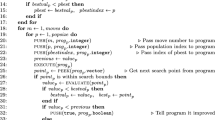Abstract
An adaptive algorithm for drifting environments is proposed and tested in simulated environments. Two powerful problem solving technologies namely Neural Networks and Genetic Algorithms are combined to produce intelligent agents that can adapt to changing environments. Online learning enables the intelligent agents to capture the dynamics of changing environments efficiently. The algorithm’s efficiency is demonstrated using a mine sweeper application. The results demonstrate that online learning within the evolutionary process is the most significant factor for adaptation and is far superior to evolutionary algorithms alone. The evolution and learning work in a cooperating fashion to produce best results in short time. It is also demonstrated that online learning is self sufficient and can achieve results without any pre-training stage. When mine sweepers are able to learn online, their performance in the drifting environment is significantly improved. Offline learning is observed to increase the average fitness of the whole population.
Preview
Unable to display preview. Download preview PDF.
Similar content being viewed by others
References
Yao, X.: Evolving artificial neural networks. In: Proceedings of the IEEE, vol. 87(9) (1999)
Kasabov, N.: Evolving connectionist systems: methods and applications. Bioinformatics, brain study and intelligent machines (2003)
Stanley, K., Miikkulainen, R.: Evolving neural networks through augmenting topologies. Evolutionary Computation 10(2) (2002)
Magoulas, G.D., Plagianakos, V.P., Vrahatis, M.N.: Hybrid methods using evolutionary algorithms for on-line training. In: Proceedings of the INNS-IEEE International Joint Conference on Neural Networks (2001)
Christenson, C., Kaikhah, K.: Incremental Evolution of Trainable Neural Networks that are Backwards Compatible. In: Proceedings of the fifth IASTED International Conference on Artificial Intelligence and Applications (2006)
Author information
Authors and Affiliations
Editor information
Rights and permissions
Copyright information
© 2007 Springer Berlin Heidelberg
About this paper
Cite this paper
Kaikhah, K. (2007). A New Hybrid Learning Algorithm for Drifting Environments. In: Okuno, H.G., Ali, M. (eds) New Trends in Applied Artificial Intelligence. IEA/AIE 2007. Lecture Notes in Computer Science(), vol 4570. Springer, Berlin, Heidelberg. https://doi.org/10.1007/978-3-540-73325-6_70
Download citation
DOI: https://doi.org/10.1007/978-3-540-73325-6_70
Publisher Name: Springer, Berlin, Heidelberg
Print ISBN: 978-3-540-73322-5
Online ISBN: 978-3-540-73325-6
eBook Packages: Computer ScienceComputer Science (R0)




